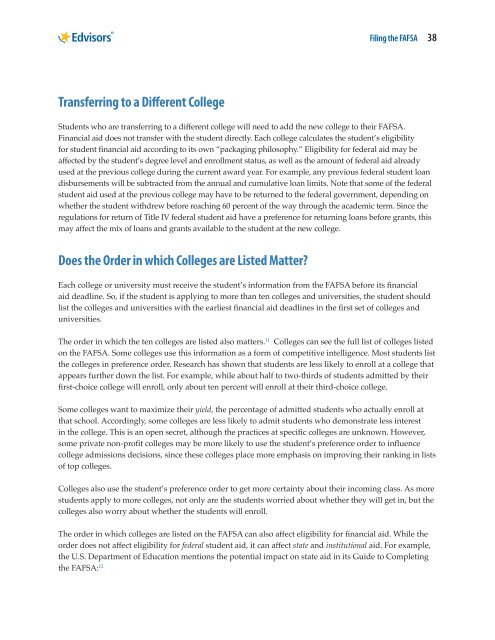filing-the-fafsa-2015-2016-edition
filing-the-fafsa-2015-2016-edition
filing-the-fafsa-2015-2016-edition
Create successful ePaper yourself
Turn your PDF publications into a flip-book with our unique Google optimized e-Paper software.
Filing <strong>the</strong> FAFSA 38<br />
Transferring to a Different College<br />
Students who are transferring to a different college will need to add <strong>the</strong> new college to <strong>the</strong>ir FAFSA.<br />
Financial aid does not transfer with <strong>the</strong> student directly. Each college calculates <strong>the</strong> student’s eligibility<br />
for student financial aid according to its own “packaging philosophy.” Eligibility for federal aid may be<br />
affected by <strong>the</strong> student’s degree level and enrollment status, as well as <strong>the</strong> amount of federal aid already<br />
used at <strong>the</strong> previous college during <strong>the</strong> current award year. For example, any previous federal student loan<br />
disbursements will be subtracted from <strong>the</strong> annual and cumulative loan limits. Note that some of <strong>the</strong> federal<br />
student aid used at <strong>the</strong> previous college may have to be returned to <strong>the</strong> federal government, depending on<br />
whe<strong>the</strong>r <strong>the</strong> student withdrew before reaching 60 percent of <strong>the</strong> way through <strong>the</strong> academic term. Since <strong>the</strong><br />
regulations for return of Title IV federal student aid have a preference for returning loans before grants, this<br />
may affect <strong>the</strong> mix of loans and grants available to <strong>the</strong> student at <strong>the</strong> new college.<br />
Does <strong>the</strong> Order in which Colleges are Listed Matter<br />
Each college or university must receive <strong>the</strong> student’s information from <strong>the</strong> FAFSA before its financial<br />
aid deadline. So, if <strong>the</strong> student is applying to more than ten colleges and universities, <strong>the</strong> student should<br />
list <strong>the</strong> colleges and universities with <strong>the</strong> earliest financial aid deadlines in <strong>the</strong> first set of colleges and<br />
universities.<br />
The order in which <strong>the</strong> ten colleges are listed also matters. 11 Colleges can see <strong>the</strong> full list of colleges listed<br />
on <strong>the</strong> FAFSA. Some colleges use this information as a form of competitive intelligence. Most students list<br />
<strong>the</strong> colleges in preference order. Research has shown that students are less likely to enroll at a college that<br />
appears fur<strong>the</strong>r down <strong>the</strong> list. For example, while about half to two-thirds of students admitted by <strong>the</strong>ir<br />
first-choice college will enroll, only about ten percent will enroll at <strong>the</strong>ir third-choice college.<br />
Some colleges want to maximize <strong>the</strong>ir yield, <strong>the</strong> percentage of admitted students who actually enroll at<br />
that school. Accordingly, some colleges are less likely to admit students who demonstrate less interest<br />
in <strong>the</strong> college. This is an open secret, although <strong>the</strong> practices at specific colleges are unknown. However,<br />
some private non-profit colleges may be more likely to use <strong>the</strong> student’s preference order to influence<br />
college admissions decisions, since <strong>the</strong>se colleges place more emphasis on improving <strong>the</strong>ir ranking in lists<br />
of top colleges.<br />
Colleges also use <strong>the</strong> student’s preference order to get more certainty about <strong>the</strong>ir incoming class. As more<br />
students apply to more colleges, not only are <strong>the</strong> students worried about whe<strong>the</strong>r <strong>the</strong>y will get in, but <strong>the</strong><br />
colleges also worry about whe<strong>the</strong>r <strong>the</strong> students will enroll.<br />
The order in which colleges are listed on <strong>the</strong> FAFSA can also affect eligibility for financial aid. While <strong>the</strong><br />
order does not affect eligibility for federal student aid, it can affect state and institutional aid. For example,<br />
<strong>the</strong> U.S. Department of Education mentions <strong>the</strong> potential impact on state aid in its Guide to Completing<br />
<strong>the</strong> FAFSA: 12


